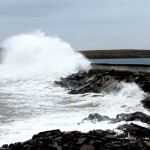

Caisson at anchor ready for deployment

(Picture: Craig Taylor)
A concrete structure known as a caisson has been towed to a temporary mooring off the Churchill Barriers ready for final deployment when conditions allow.
It is hoped that the placement of the structure will alleviate problems encountered at the Second Barrier when waves sweep over the causeway in certain tidal and wind conditions in the winter months.
Orkney Islands Council aim is to deploy the caisson off the Second Barrier to test the potential for using devices of this kind to reduce the impact of waves on the causeway.
Improved weather conditions over the weekend meant the caisson could be towed from Lyness through the Pentland Firth and in to Kirk Sound, where temporary moorings have been established off the First Barrier.
The tow was undertaken by the Orkney Towage tug Einar, before being passed to the Leask Marine vessel C-Chariot for final manoeuvring at the mooring point.
Gavin Barr, Orkney Islands Council’s executive director of development and infrastructure, said: “The second phase of deployment to the Second Barrier will take place at the earliest opportunity when tide and weather conditions permit and after sea bed preparations have been completed.
“This will complement ongoing engineering and technical studies on potential wave overtopping solutions, including those that involve the possibility of tidal energy generation.”
Caissons are concrete structures that can be sunk and re-floated as required and are used for a variety of harbours and seabed projects.
The council has been undertaking work since the spring of 2015 on the necessary planning, survey, consenting and risk assessment processes needed before the deployment could take place.
Following a competitive tendering exercise, the contract to deploy the caisson was won by Orkney-based Leask Marine. The company has been undertaking preparatory work with the caisson and at the site off the Second Barrier.